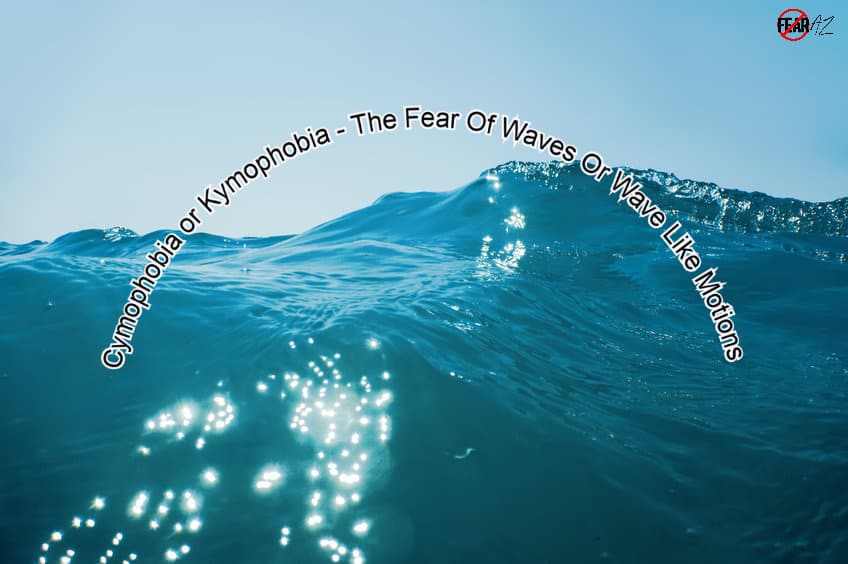Share This Article
The Fear of Waves or Wave-Like Motions
Going up and down, up and down, wave after wave, endless energy. Do these simple thoughts cause you discomfort?
Do you avoid the wave pools at water parks? Does your stomach churn at the thought of activities like surfing and paddle boarding? What about a big boat riding up and down on fifteen-foot rolling waves, or a simple walk on the ocean beach? If your answer was a firm yes, you may have cymophobia or kymophobia, the excessive fear of waves or wave-like motions.
Reading about floods, tsunamis, and hurricanes on the news must make your heart race and your mouth run dry. You probably can’t even think of living near deep, large bodies of water, such as the ocean.
Simply being near the sea can aggravate your fears of drowning or suffocation by huge waves. It can feel impossible to push away thoughts of waves to avoid triggering your cymphobia. But it doesn’t always have to be this way. To deal with this phobia, first try to have a deeper understanding of it.

What Is Cymophobia?
Cymophobia is the irrational fear of waves, sea swells, and wave-like motions. The meaning of cymophobia originates from the Greek word cymo meaning “waves” and phobos meaning “fear”. This phobia is also linked with the phobia of water called aquaphobia.
It might sound like an odd thing to fear, but it’s something you can learn to overcome. If you suffer from cymophobia, don’t be disheartened. You can deal with it by learning more about its causes, symptoms, and treatments.
Cymophobia Causes
Individuals with cymophobia tend to be afraid they’ll be consumed, drowned, and suffocated by waves, even when they’re asleep. There are several factors that can result in someone developing cymophobia. Here are a few notable causes that may be responsible:
Past Experiences
If a person had traumatic experiences with water at a young age or was a victim of bullying, there is a greater likelihood of them developing cymophobia. It could be because someone pushed them into the deeper end of a pool, the sea, or even off the slide, which may have been traumatizing enough to have a lasting impression.
Genetics
Studies have shown that phobias can run in families. There could be one or more family members who have a fear of waves and may have passed on those genes to their offspring.
Upbringing
Some people may have been raised in environments where others struggled with fear or phobia. These fears can be learned. One may develop a sense of fearfulness of any kind of danger, including that related to waves or wave-like motions. Such long-lasting fears can progress into phobia.
Symptoms of Cymophobia
There are various signs one can watch for when diagnosing cymophobia. The level of fear individuals experience may differ, but the primary symptom with all phobias is anxiety.
If left untreated, any phobia—including cymophobia—can further escalate and lead to other conditions such as depression and panic attacks. Knowing how to manage anxiety can help a person overcome their fear of waves.
Phobias are complicated, and they rarely manifest in the same way in different people. A person suffering from cymophobia may be comfortable with swimming in a pool but experience discomfort around a large body of open water like the sea or ocean.
Symptoms such as fear and panic are also common as the brain can create imaginary situations without the person actually experiencing it. A person need not be exposed to waves or wave-like motions to be triggered.
So, if you’re wondering, “do I have cymophobia,” here are some of the symptoms you can watch for:
Physical Symptoms
- Sweating
- Choking sensation
- Hot flashes or chills
- Trembling
- Shortness of breath or difficulty breathing
- Nausea
- Headaches and dizziness
- Pain or tightness in the chest
- Dry mouth
- Rapid heartbeat (tachycardia)
- Hyperventilation
- Rise in blood pressure
- Fear of fainting
- Confusion or disorientation
- Need to visit the washroom frequently
- Ringing in the ears
- Numbness
Mental/Emotional Symptoms
- Anxiety and fear
- Fear of dying
- Fear of losing control
- Fear of harm or illness
- Feeling lost or disconnected
- Fear of shame, guilt, self-blame
- Feelings of anger, irritability, mood swings
- Feeling disconnected and hopeless
- Feelings of dread
- Confusion
- Withdrawal from others
Cymophobia Treatment
Having a phobia can be debilitating. It can affect one’s social life as well as interpersonal relationships. However, there are various ways to cope with this fear.
So, how do you deal with cymophobia? The first step to dealing with cymophobia is to accept the fact that you have a problem. Admitting that you have an irrational fear and seeking help is key in your journey to recovery.
While there is no one specific cymophobia treatment, you can explore different treatment options and see what helps more. Usually, you can go about this in two ways: one is self-help and the other is by seeking professional help.
Self-Help
Before you consider getting help from a professional, you can try a number of self-help techniques to deal with cymophobia. Reassuring statements and positive reinforcements can go a long way in dealing with the fear. In addition to the methods listed below, you can also try relaxation techniques like deep breathing, controlled breathing, or meditation.
Exercise Regularly
Even if you don’t get time to exercise because of your busy schedule, try and squeeze in some light movements. Exercise helps release endorphins that will make you feel calmer and more relaxed. It can also help with releasing repressed anxiety.
Yoga and Meditation
Yoga is known to reduce stress and anxiety as it tends to stimulate a meditative state of mind. You can try out a beginner’s yoga class and practice it for a few days to see how it affects you. Yoga along with meditation is known to help people attain a calmer and balanced outlook.
Professional Treatment
Seeking professional help can allow you to better understand your phobia. Once you identify the root of your phobia, you can begin to figure out how to overcome your fear of waves and wave-like motions.
Talk Therapies
Talk therapies are a type of counseling between a therapist and a patient. These treatments are physically non-intrusive and help create a safe zone for the patient where they can unburden all their thoughts about their fears and anxieties.
The goal is for the patient to more closely examine their thoughts and feelings and discover more about themselves in a non-judgemental environment.
Cognitive Behavioral Therapy (CBT)
Another popular treatment therapists use is cognitive behavioral therapy, or CBT. In this treatment approach, the patient discusses their phobia and how they developed it with the therapist. It helps determine their triggers.
During these conversations, the therapist will try to understand the patient’s past experiences and thoughts about the fear.
Coping with Cymophobia in the Long Term
Not all phobias can vanish completely. You may have to live with them—but that doesn’t mean you need to live in fright. The most important thing to remember is to never give up hope and to keep trying to overcome your phobia.
Connect with a professional or find someone trustworthy to talk to. Don’t shy away from asking for help from others. You can even try to get in touch with people who have similar experiences. It will minimize your fear and help you manage it better.
Final Thoughts
While cymophobia may not occupy your mind 24/7, don’t ignore it. It might not limit your day-to-day activities, but left ignored, it can significantly affect your life.
You may not be going deep-sea diving anytime soon, but with consistent treatment, you may find yourself enjoying the sound of waves.




